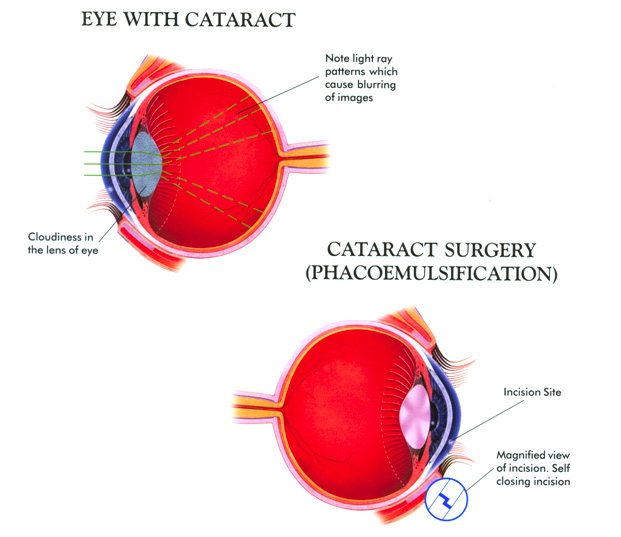CATARACTS IN ADULTS
 Normally our eye works like a camera. Just like camera, we have a lens & at the back a film (called Retina). Light travels through the lens & gets focused clearly on the film. The film converts the light rays into electric impulses & sends it to the brain via the optic nerve. So a clear lens transmits light fully to give a clear image. On the other hand, if the lens becomes partially of totally opaque, then the light cannot get focused on the film. Instead it gets scattered all around leading to a blurred & cloudy image.
Normally our eye works like a camera. Just like camera, we have a lens & at the back a film (called Retina). Light travels through the lens & gets focused clearly on the film. The film converts the light rays into electric impulses & sends it to the brain via the optic nerve. So a clear lens transmits light fully to give a clear image. On the other hand, if the lens becomes partially of totally opaque, then the light cannot get focused on the film. Instead it gets scattered all around leading to a blurred & cloudy image.
Common symptoms of cataract include:
- A painless blurring of vision
- Glare, or light sensitivity
- Poor night vision
- Double vision in one eye
- Needing a brighter light to read
- Colors looking faded or yellow
How quickly the cataract develops varies among individuals and may even be different between the two eyes. Most age-related cataracts progress gradually over a period of years. Other cataracts, especially in younger people and people with diabetes, may progress rapidly over a short time. It is not possible to predict exactly how fast cataracts will develop in any given person Surgery is the only method of treating cataracts. No drops can dissolve cataracts. Timing of surgery depends on the individual visual needs & whether the reduced vision is affecting the normal routine of the individual. A person who is involved in driving or professions requiring crisp vision can go for an early surgery. In the past when modern microsurgical equipments were unavailable, surgeons used to wait till the cataract if fully mature to remove them. Now with very good microsurgical equipments & Phaco emulsification machines, we can remove the cataracts even in the earliest stages if necessary.
Cataract surgery
Cataract surgery is one of the most successful surgeries on the human body. It is usually done as a day care procedure. With the latest procedure of Phacoemulsification (mistakenly called laser surgery), it is possible to remove the cataracts with a very tiny incision & replace the power of the natural lens with a foldable acrylic lens (IOL).
Phacoemulsification can be performed without the need for an anesthetic injection by an experienced surgeon. Also since the incision is very tiny, there is no need for sutures to close the incision.
We call this procedure the NO INJECTION, NO STITCH, NO BANDAGE Cataract surgery, performed with Bausch & Lomb STELLARIS Phacoemulsification system at Samprathi Eye Hospital & Squint Centre.Some centers also call this as Eye drop surgery.
Cataractous lens is replaced with a artificial lens called "IOL" or Intra Ocular Lens. This avoids the need for thick glasses after surgery. However the routinely used IOLs are called "Monofocal IOL", meaning the lens is focused for distance vision & patients will need reading glasses to see near objects.
Mutifocal IOLs are also available, which help the person see both far & near without glasses. However there are certain limitations in the technology, due to which patients may experience glare while driving at night.
We at Samprathi Eye Hospital offer an array of IOLs & your Doctor will discuss the pros & cons before surgery.

